Home | Front Page | Index | Blog | New | Contact | Site Map
La Cruz
Bahia Salinas
Playa Coco
Lake Arenal
Santa Elena
Cafe Britt
European School
Aronson Family
La Fortuna
San José
Cartago
Chirripo
Puerto Jimenez
Wildlife
Foto Show
Route Maps
Belize
Guatemala
Honduras
Nicaragua
Panama
Mexico 2003-04:
2003-04
A long, long time ago, perhaps back in 1996 or 1997, we met a couple who were selling their house in Lincroft, a few miles from where we lived in Red Bank, and retiring to Costa Rica. We learned from them that lots of Americans retire to this small, tropical, Central American country. What was it like, we wondered? With little idea then that we would ever find out, we now know the answer.
Another reason for being curious about Costa Rica was the attitude of more northerly central American countries to its country and people. We heard several remarks like: "They're arrogant." "They're so sure of themselves." "They look down on us." When we met a small group of costariccenses, as they call themselves, in Granada,
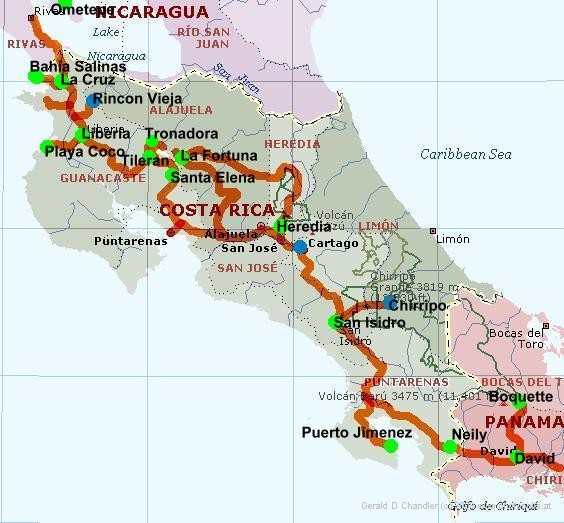
Coast Rica Route |
Our reaction to the country was much like our reaction to its people. It is more like the USA in several ways: things work a little better, the standard of living is higher, the quality of workmanship and the level of maintenance seemed higher too. In several places you can drink the water, as we did in Heredia. Perhaps you can throughout the country, but we were cautious and only after assurances from friends did we start to assume that tap water was clean. We also said goodbye to smelly buckets of used toilet paper. That was a relief indeed! We found a better selection of hotels at lower prices than further north. And last but not least, we loved the Costa Rican traditional lunch plate, the casado. Great value for money, it offered steamed white rice, dry and tender like it should be, grilled meat, sauteed bananas, red beans, and salad.

Bahias Salinas, seen from cliffs at La Cruz, Costa Rica |
Our first taste of Costa Rica came at the Pena Blanca border crossing. We had started the morning on the isle of Ometepe, Nicaragua, where we caught the ferry to the mainland and then drove 30 km southeast along the shore of Lake Nicaragua to the border. The Costa Rican procedures were not much different than elsewhere and easily accomplished. We were forced to buy official Costa Rican car insurance for $15 inspite of our insistance that we had a policy good throughout Central America. Later we learned that our policy was sold by the government monopoly and that our coverage was less than minimal.
We drove away from the border very relaxed as to time: we had received 90 days for car and ourselves. This would prove to be plenty. We initially thought we'd be in the country about three weeks — roughly the same as Honduras and Nicaragua; little did we suspect that we'd double that to more than six weeks.
Our first two nights in Costa Rica were spent in La Cruz, just 15 km past the Nicaraguan border. We could have gone on but as usual after a post-meridian border crossing we sought a place to stop and get our bearings. La Cruz turned out to be tiny, if not as tiny as some other border places we stayed in. We thought ourselves lucky to find on a side street the Hotel Bella Vista, run by a German, with a fine view of the Pacific and a nice swimming pool. It turned out to be sort of a contradiction: although its public places were nice all of the rooms, including ours and those in a new wing under construction were boxy and of cheap construction.
We used La Cruz as a basis for going south to the Parque National Santa Rosa. There we got our first taste of the $6 entry fees that Costa Rica charges all foreigners (locals pay much less). We heard that it was a non-cloud forest park where lots of wildlife was visible. We were there in the wrong season, at the wrong time of day, and in the wrong (more accessible) parts of the park and saw just one animal in the several hour walk we made along a 4-Wheel drive road. We did learn that the old Hacienda there was the site of a battle in which empire builder William Walker was defeated by a Costa Rican led coalition; we saw the hacienda now converted to a museum.

Pool and beach at Bahias Salinas, Costa Rica |
We left La Cruz and drove toward the Pacific with the intent of seeing what it was like and then going on south to Liberia. In our two day stay at Hotel Bella Vista we had discovered it is not on a side road; in fact the road in front leads out to and 19 km around the Bahia Salinas. At the very end we found, to our surprise (even though there were two roadside signs advertising it) the Bahia Salinas tourist resort. It was empty of paying guests — the Semana Santa rush was over and the time was being spent in repairs, they had a wonderful view and a great swimming pool, and so on the spur of them moment we decided to spend a week there. The manager, initially taken aback, accepted our 30%-off offer, and we settled in to days of swimming, reading, and high wind or stultifying heat.
Finally, reluctantly, we gave up Bahia Salinas resort, drove the 19 km gravel road to La Cruz, and headed south to Liberia. We were not 5 km further south when we were stopped at a police border checkpoint, just as we had been on our way to P. N. Santa Rosa. Annoying maybe, but all very friendly, and we went on with little delay.
In Liberia we found a town three times the size of La Cruz with what we considered less choice in hotels. Our room — a simple box — was probably just as good at La Cruz but there was no pool. We rejected the only better place, much higher priced, because it was not much better. In our two day stay we did find a restaurant we liked and enjoyed an evening walk through town. A sad, and warning note: at the restaurant we overheard and then talked to a young American couple. They had parked their rented car, with goods and important papers fully visible on a side street; they came back to find window broken and all things gone.
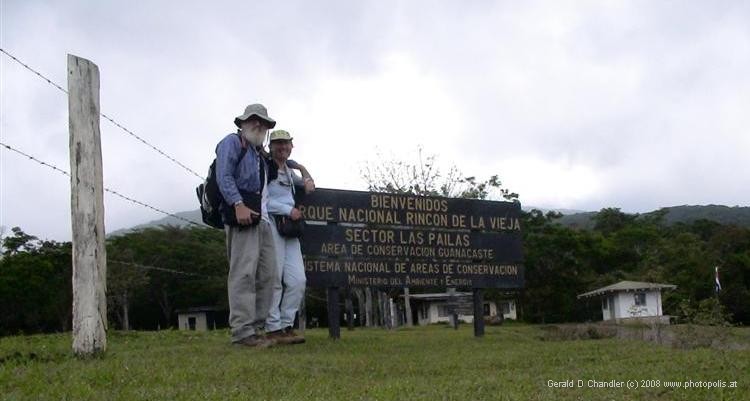
Gerry and Jan at Rincon de la Vieja N. P. |
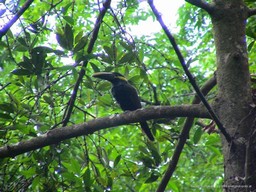
Toucan at Rincon de la Vieja |
Liberia was our base for a full-day excursion to P. N. Rincon de la Vieja, named after its highest point, a semi-active volcano, which in turn is named, it is said, after an old woman who threw herself into the volcano after the loss of her lover. The drive there included 25 km over gravel road much, much worse than the Bahia Salinas road. (While Costa Rica is the richest country in Central America it has many miles of dirt road and many potholes in those paved.) Two thirds of the way along this road is a country inn where we think we should have stayed. In the park we had a fun three hours walking among boiling mud pots and steaming vents and picnicked, accompanied by a large iguana. Afterwards we walked part of the trail to the peak, seeing wonderful wildlife, including a mono monkey and a toucan.
Another of our many time-detours occured when we left Liberia. It is the northern entrance to the Nicoya Pennisula; the southern end, about 150 km from us and Libeia, is a popular weekend and vacation destination among Costa Ricans. We are told there are good surfing beaches as well as sandy, swimming one. We decided to skip all of that and instead just take a look at the beaches nearest Liberia -- the drive over is easy and short — and see what another American retirement area looks like. When we got to Playa Coco we found a terrific pool at LP recommended Coco Palms Hotel. Of course we stayed two days — long enough to suffer from the heat when the aircon failed after an earthquake.
Then it was off to see if we could get the car to or near Monteverde/Santa Elena, an eco-tourist resort area that all the maps showed as being accessible only over unpaved roads. We set out in the direction of Tilaran, where the paved road seemed to end. We chose the restaurant of Hotel Guadaloupe for lunch. Because the food was good and reasonably priced we looked at a room; because it was good and reasonably price we checked in.
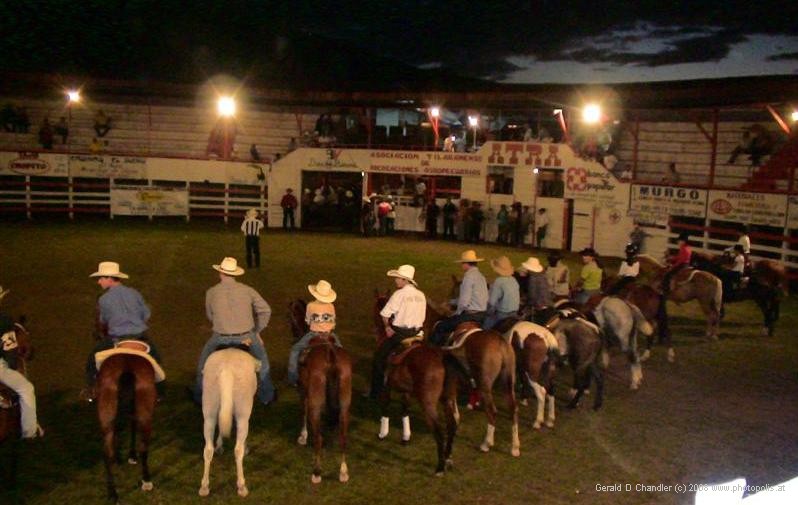
Horsemen at opening of Tilaran Annual Rodeo |
But there was still time in the afternoon to drive 5 km to Lake Arenal and check it out. There we stumbled on the Arenal Country Club and checked it out. The manager was anxious to make a deal and we ended up with a 3-bedroom, 3-bath apartment for a week for half-price. This gave us great views of the lake, morning rain clouds, afternoon humming birds, a chance to make our own popcorn, to cook (and melt an aluminim pan), and another pool to enjoy. Twice we went back to Tilaran to attend their annual rodeo -- once for amateur night and once for something fancier.
The drive from Tilaran to Santa Elena was 40 km through very lovely rolling, green hills and was possible because it wasn't rainy season yet. If it had been even a 4-wheel drive would have had trouble. By luck, we found as usual, the best place in town for us, the Hotel Sunset. It is more accurate to describe it as out of town, a comfortable 2 km walk, and that and the hill on which it sat made it delightlyfully serene. In four days we had four home-cooked breakfasts, explored 8-km distant and cloud enshrouded Cerro Amigo, walked 8-km to the Mirador to see (and not see) Volcan Arenal, made a trip around Hotel Sunset's own private 2-km bird watching trail, and had nice conversations with a half dozen other guests while watching sunsets or birds or sunsets and birds. Then we drove 30 km of unpaved road to the Pan American highway, getting great views of the Golfo de Nicoya.
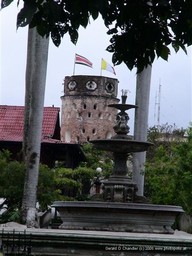
Heredia colonial tower, El Fortin |

Church on colonial square, Barva, Heredia |
Our next goal was Heredia, a suburb of San Jose, where we had been invited to stay with the Aronsons. Our drive that day took us from remote Santa Elena, down the mountain, along good highway, then an hour detour to Puntarenas (another jumping off point for the beaches of the southern Nicoya Pennisula) and finally a long climb into the mountains around San Jose and its greater metropolitan area. We coaxed the car up the hill and we would have had no problem except we ran into slow moving trucks, deadly for us and something we had not expienced since Guatemala. The traffic was so rushed that we missed the proper turnoff to Heredia and went 7-8 km out of our way.
In Heredia and at the Aronson's home our world was turned upside down: We went from small hotel in small town with little traffic to large comfortable home in large suburb of large metropolitan area with much traffic, some of it, if not frightening, difficult. The Aronsons spoiled us and we spent a good part of our time there indulging ourselves with books from their fine library. We were the guests of Steve Aronson and son Benjamin for a tour of family owned Cafe Britt and we were the guests of Anne Aronson and son Tupie for a tour of family founded and run European School; both were very interesting days. On top of that, in a visit broken by a 2 day-excursion to Volcan Arenal, we were treated to good meals, conversation, and wine and to two parties.
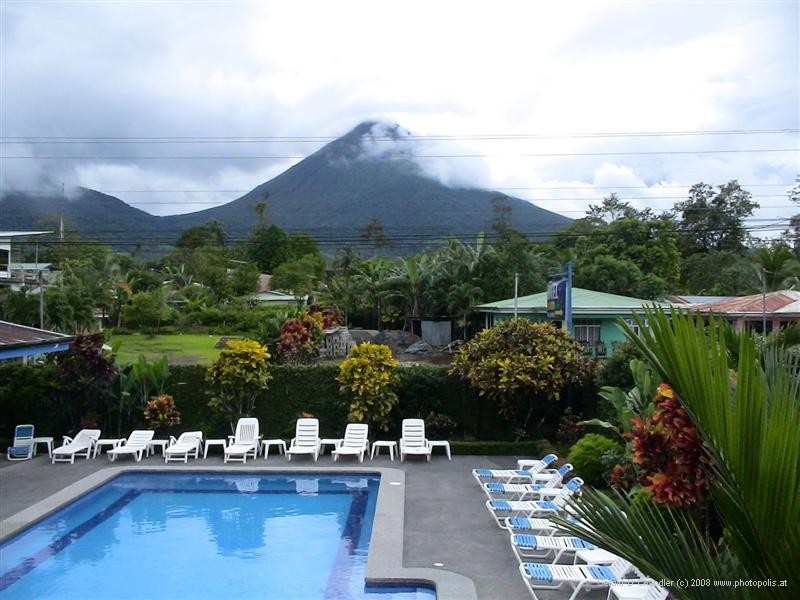
Volcan Arenal seen from Hotel Los Boscos, La Fortuna |
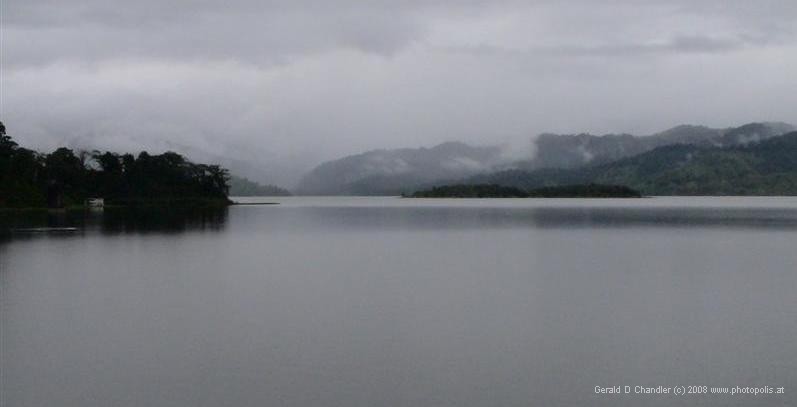
South-east end of Lake Arenal near Volcan Arenal |
Volcan Arenal sits about eight kilometers north of the Mirador at Santa Elena and and another eight kilometers south of the La Fortuna de San Carlos. At La Fortuna, for a half-hour the modest lady came out of the clouds and we saw her in her spendor. Photos show it as fiery splendor with red lava coming down the sides; but they are time-lapse photos. We at least could see white wisps moving down the slopes; we were assured they were large, white-hot blocks. Our major activity, beside TV and reading was a half day walk to La Cascata de Fortuna, which was worth it for the site, but over priced at $6 each. We took a drive up to Lake Arenal, getting to see it in the sunshine and clouds, and from the dam that forms the lake got another view of Volcan Arenal.
Our return to Heredia was done in a late morning and long afternoon. We stopped for lunch on the slopes of Volcan Poas where we had a fine, if unexpectedly expensive, Costa Rican national dish, a casado. During lunch we learned the ins and outs of chicken raising in Costa Rica and its strategy in trade talks. After lunch we drove up and up the slopes of Poas, getting more and more into the clouds and the car getting hotter and hotter. By the time we turned around something had happened to the generator and we made it back to Heredia on battery.
Back in Heredia from two days in La Fortuna, we quickly got our generator repaired with the kind help of Tupie Aronson. We packed two trips into Central San José, our first ones there, around the repairs. We walked around a good part of the downtown, which had pluses and minuses like any big city. Around the corner from the century old and recently restored Theatro Nacional (where we attended a concert heavy on new music that displeased us) are many low priced stores on streets with a trashy feeling. The Parque Morazon and Parque Espana are both pleasant, with many small bronze monuments and the Parque Nacional is a gem. Down a hill from the central pedestrian zone we enjoyed a stroll in Bario Amon, where many Victorian style buildings give a feeling a bit like Haight-Asbury. While in one book store Gerry was taken aside by the owner who praised a certain coffee-table book about San Jose. The man had written it himself and taken all of the photos. It was pretty good.

Interior of La Basilica de Nuestra Senora de Los Angeles, Cartago |
Technically we could have stayed another seven weeks in Costa Rica. But we felt we had to get on the road to Panama and then South America. So we pried ourselves out of the embrace of Anne Aronson and set off for Cartago and San Isidro de General. Catago was the old capital of Costa Rica; we saw nothing of historical note because there is little or no such stuff. It is the home to the lovely post 1926 earthquake Basilica de Nuestra Senora de Los Angeles. It is also the gateway to Volcan Irazu, which we bypassed because we didn't want to try our luck with the car.
San Isidro is the gateway to Chirripo, the highest mountain in Costa Rica and we decided to walk part way up its 3820 meters. After a nights stay in a pleasant hotel we drove to the Chiripo gateway, the first half paved and the second not. Our hike was pretty tought on us; in just over one km the trail ascends 300 m. That's 30% slope! It took us an hour plus — actually not so bad. But the threat of rain, which became a fact, turned us around at 1750 m.
We next actually deliberately and with forethought turned down the chance to idle away a few more days. Quepos is a popular spot on the coast and a gateway to Manuel Antonio N. P. A luxury resort was advertising a true bargain and we would have gone except that from San Isridro it would have meant backtracking and, much worse, going each way over about 40 km of gravel road. Instead we went south, destination the Osa Pennisula.
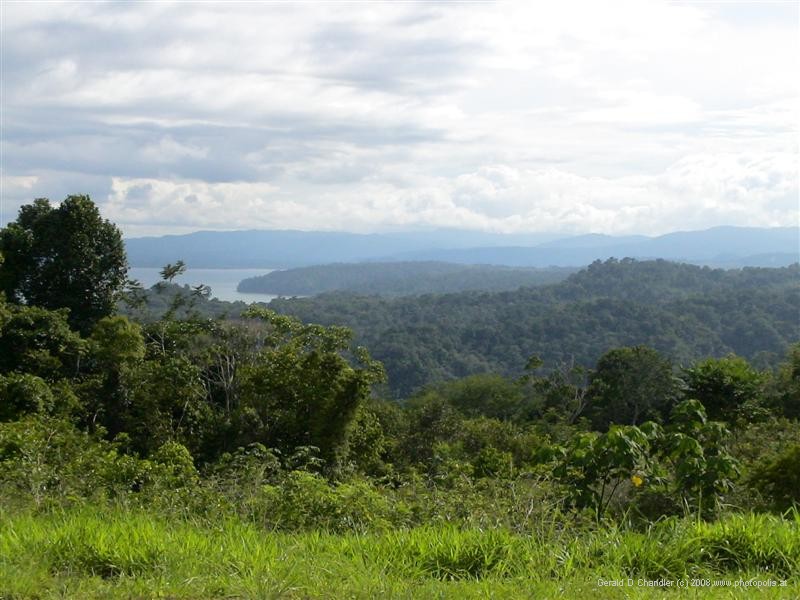
View of Gulfo Dulce from heights of Osa Pennisula |
Our goal was again wildlife, said to abound in the pennisula and in particular the Corcovado N. P. But we were up against it: all the likely options of LP seemed much more expensive than we wanted. We went to Palmar Sur in seach of lunch and more informaton. Neither turned out too satisfactory. We did decide that a costly taxi and boat to get to Bahia Drake wasn't worthwhile. From information obtained from a group of young Americans who had been surfing at the southern end of the Osa Pennisula we concluded we could drive as far as Puerto Jimenez and use it as a base for hiking. That's what we did and were rewarded on a hike by seeing a pair of wild parrots and a pair of fighting Scarlet Macaws.
Puerto Jimenez is 72 km from the Interamerican Highway. The first 40 km has a great number of potholes and the last 32 are unpaved. Going in we suffered a heavy rain storm. Coming out it was dry but slow going. Just when we were congratulating ourselves for surviging this trek with no damage to car or tires we were faced with the choice of either verring into an on coming heavy truck or meeting a major pothole head on. Gerry chose the pothole and shortly thereafter we had a flat tire. The good news is that with only 12 km backtracking we found a repair place and had an fixed tire two hours later.
That left us just enough time before sunset to drive to the last town before the border, Neily. There we spent a day doing mostly nothing, but Gerry did take a late afternoon walk trying to reach the hills that sit behind the town. No matter how far he went they always seemed to recede. After two nights we crossed into Panama and went on directly to David.
